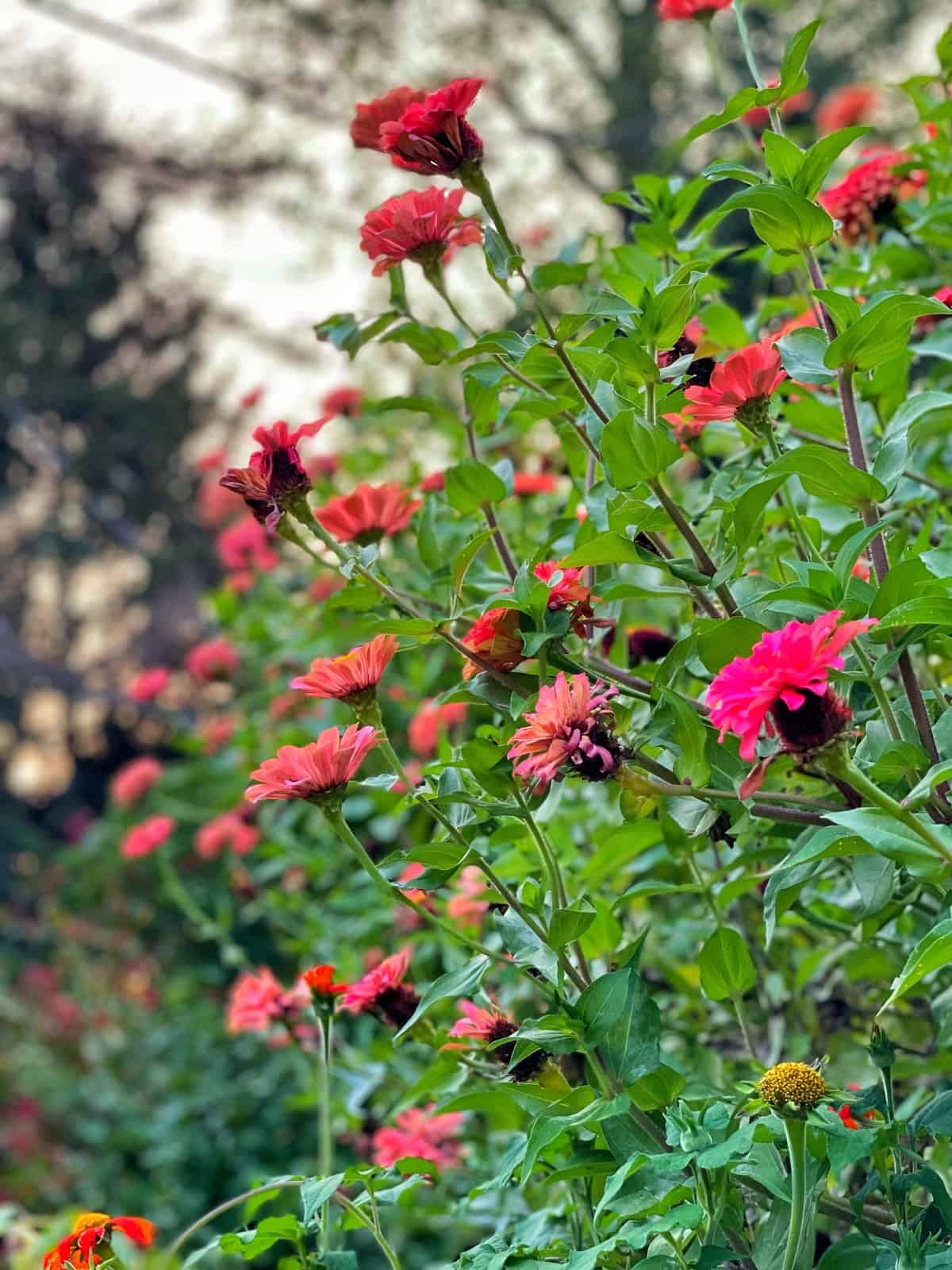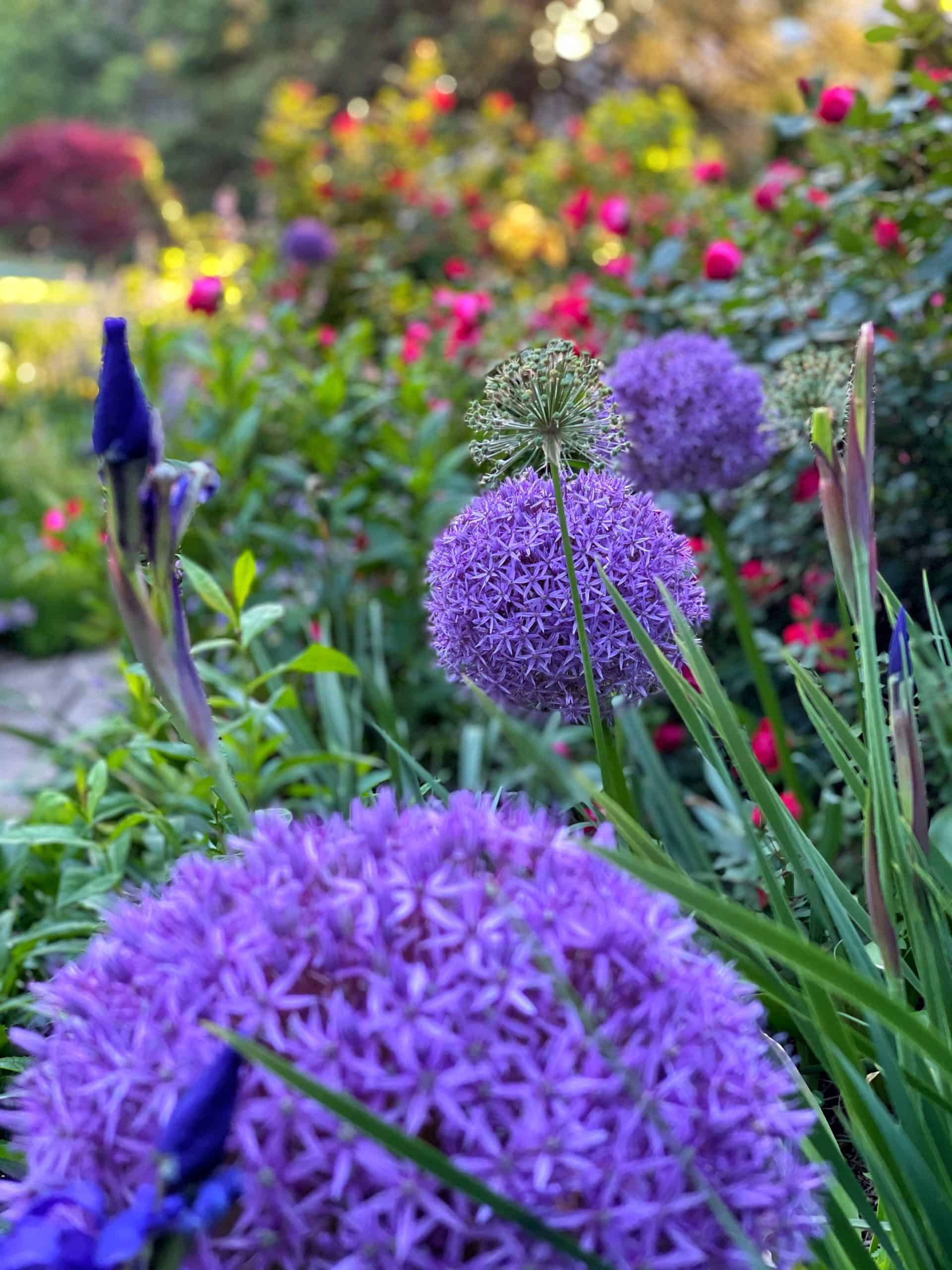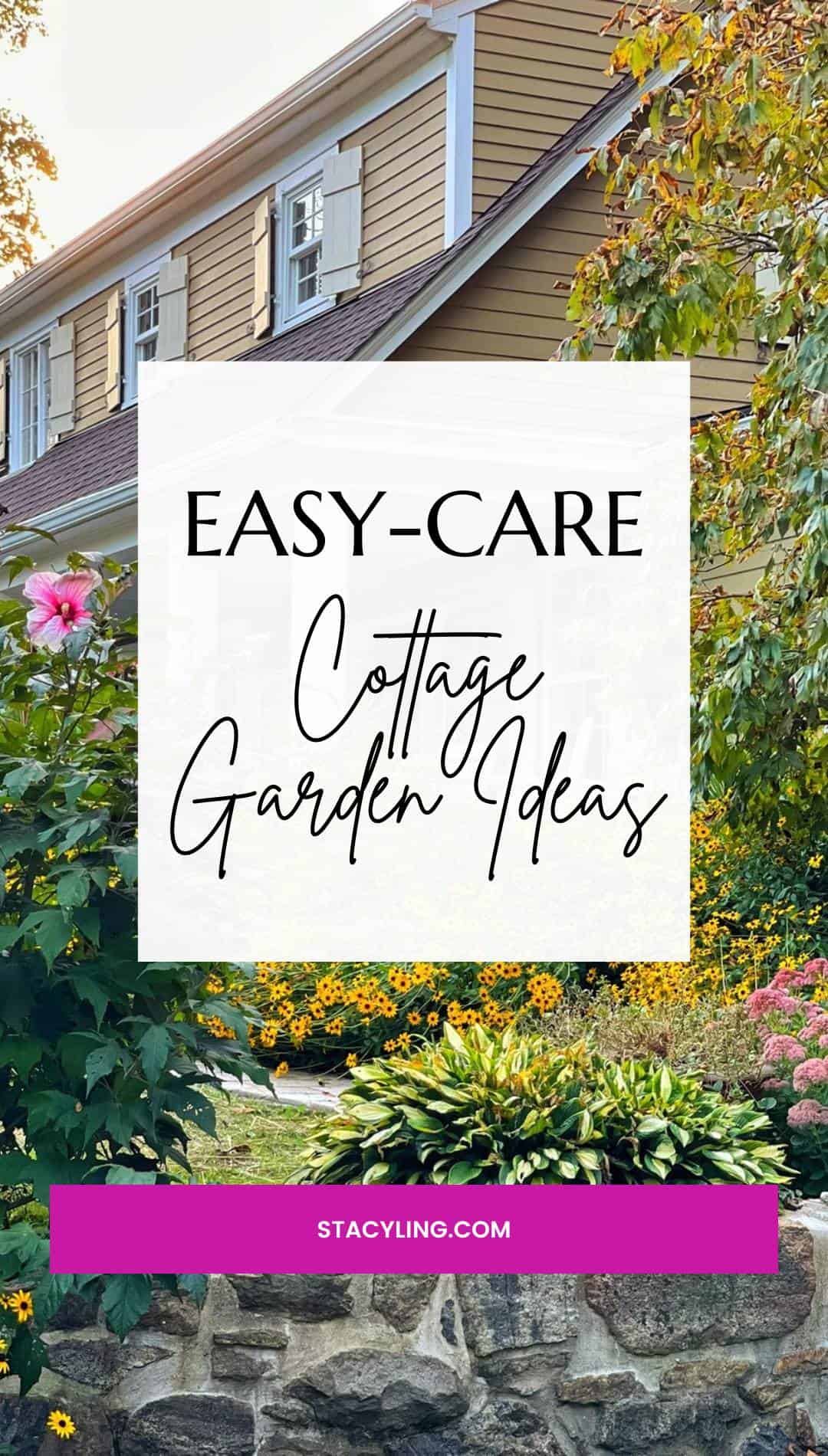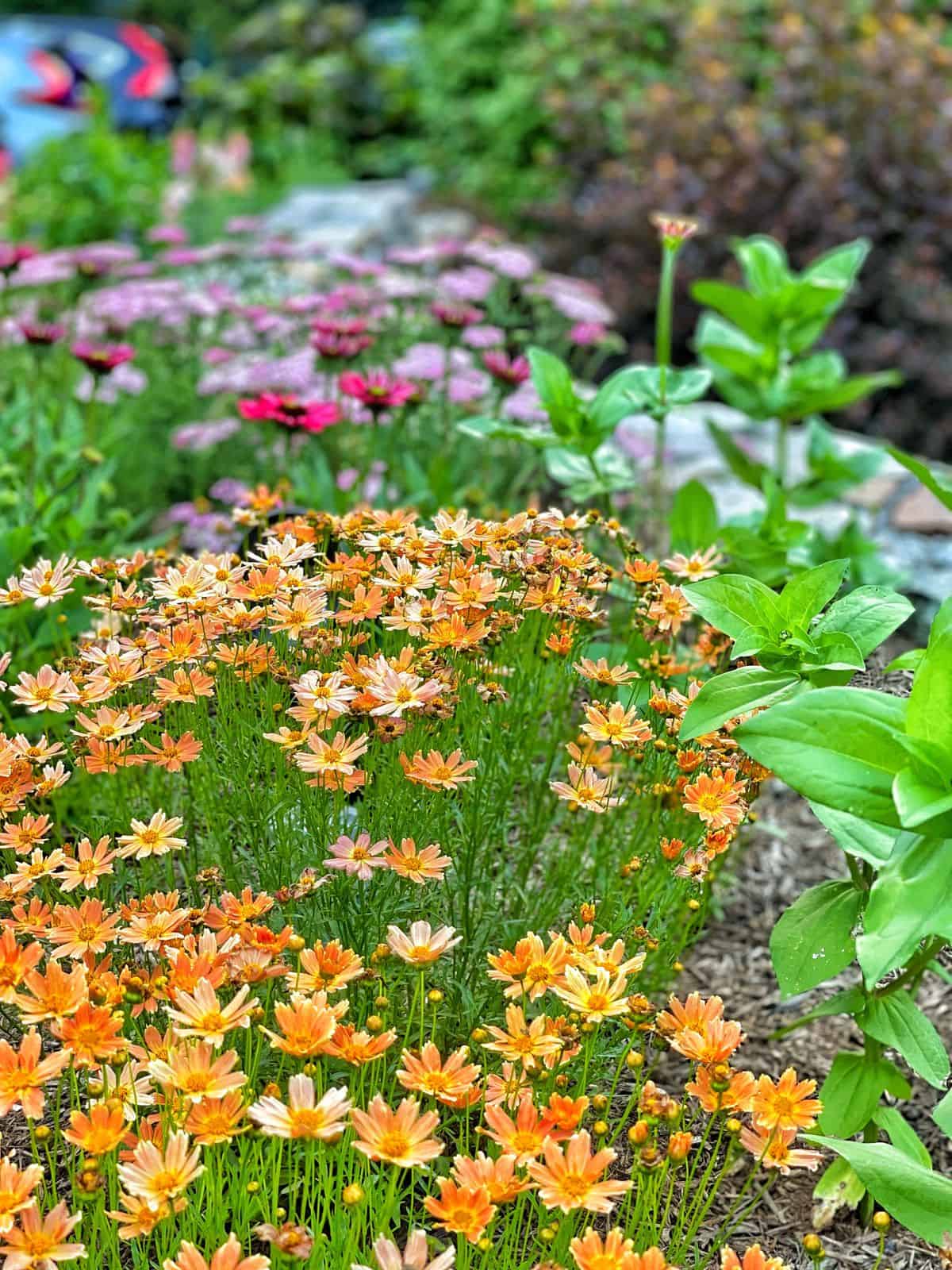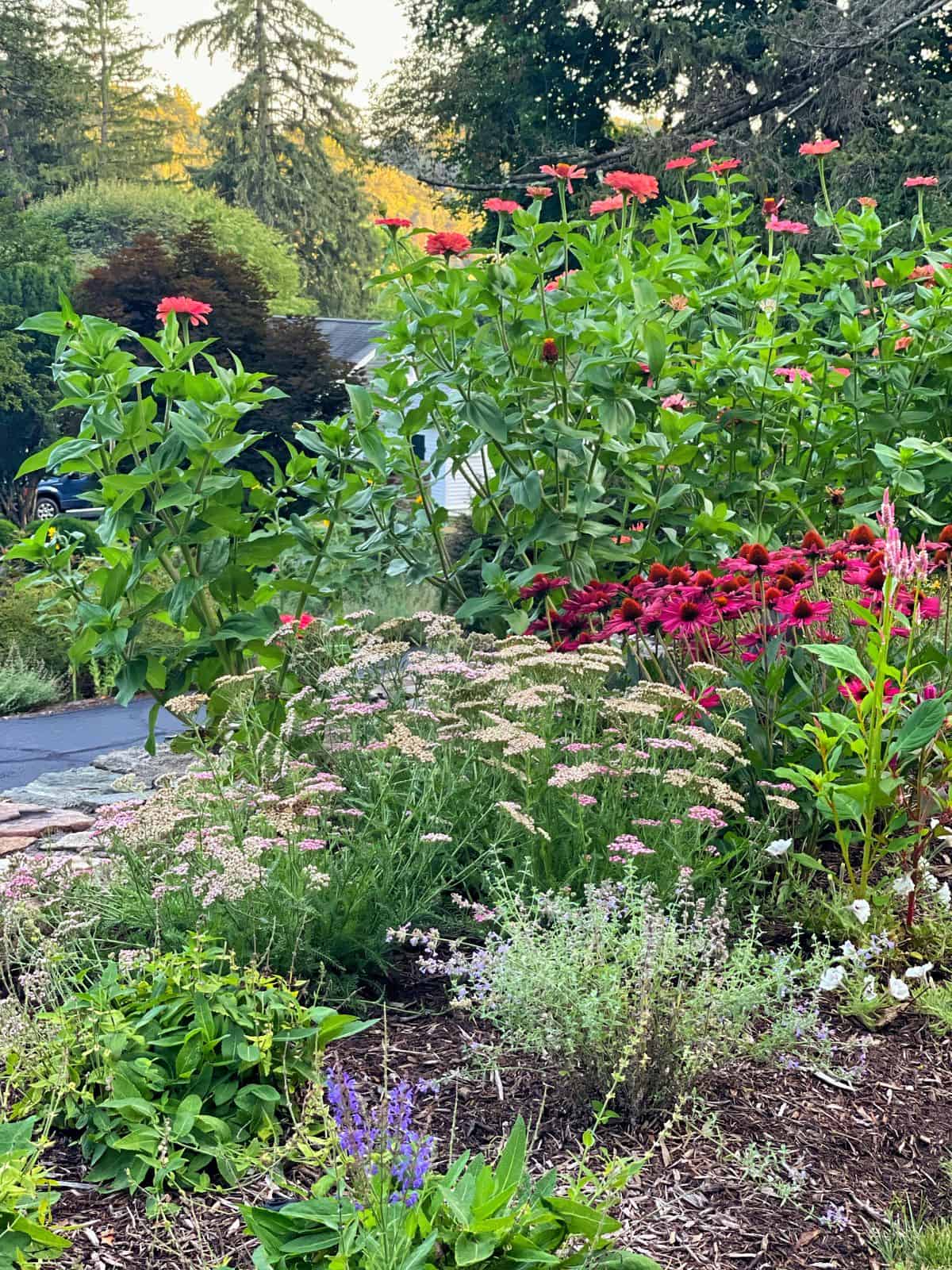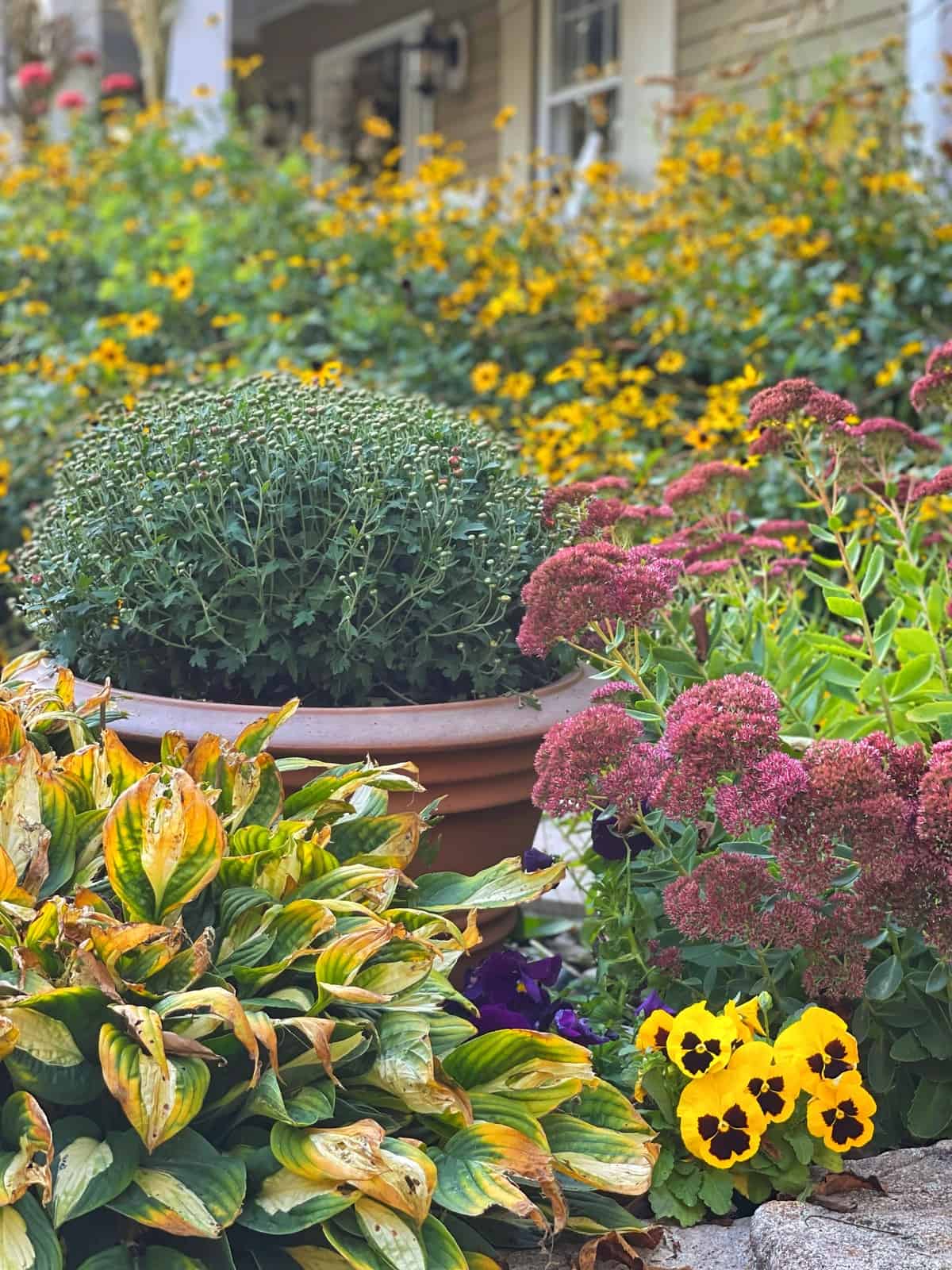Short on time? Try these charming, low-maintenance cottage garden ideas with easy flowers and simple design tips for beautiful blooms.
Have you ever dreamed of a garden overflowing with colorful blooms, a charming haven that requires minimal effort to maintain? That’s the magic of a low-maintenance cottage garden. Imagine a picturesque blend of vibrant flowers, attracting butterflies and bees, without the demands of constant pruning, staking, or fussing.
In this guide, we’ll explore the design, plant selection, and care tips that will help you create your own beautiful and effortless cottage garden, bursting with color from spring to fall.
(Posts on stacyling.com may contain affiliate links. Click HERE for full disclosure.)
What is a Cottage Garden?
Imagine a garden where vibrant blossoms spill onto winding paths, where the air is filled with the fragrance of roses and lavender, and where butterflies dance among a tapestry of colors and textures. This is the essence of a cottage garden—a charming and relaxed space that evokes a sense of rustic beauty and effortless abundance.
Unlike formal gardens with their strict lines and demanding upkeep, cottage gardens embrace a more carefree approach, allowing plants to mingle and intertwine in a delightful, seemingly haphazard way. This informal nature, combined with a diverse mix of easy-care plants, makes them surprisingly low-maintenance, perfect for gardeners of all skill levels.

What is the difference between a cottage garden and a formal garden?
To further understand the unique charm of a cottage garden, let’s compare it to its more structured counterpart: the formal garden.
| Feature | Cottage Garden | Formal Garden |
|---|---|---|
| Design | Informal, relaxed, asymmetrical | Structured, symmetrical, planned |
| Plant Variety | Diverse mix of annuals, perennials, shrubs, climbers, herbs, and even vegetables | Often focuses on a limited selection of plants for a cohesive look |
| Maintenance | Low-maintenance, embraces imperfections | Requires more upkeep, pruning, and shaping |
| Overall Feeling | Charming, whimsical, abundant | Elegant, orderly, controlled |
Cottage Garden Ideas: Embracing Uniqueness
While the informal nature of cottage gardens is appealing, it’s important to remember that each garden is unique. Just as every gardener has their own style, every plot of land has its own microclimate and conditions. So, while it’s wonderful to gather inspiration from others, don’t be discouraged if your garden evolves differently. Embrace the individuality of your space and adapt ideas to suit your own environment and preferences.

What Makes a Low-Maintenance Cottage Garden?
Creating a thriving cottage garden doesn’t have to be a time-consuming endeavor. By understanding the key elements of a low-maintenance approach, you can achieve that beautiful, abundant look without sacrificing your free time. Here’s the secret:
Strategic Plant Choices
Opt for plants that are known for their resilience, disease resistance, and minimal care requirements. Look for varieties that don’t need staking, are drought-tolerant, and have a long blooming season. Some excellent examples include:
- Black-eyed Susans: These cheerful yellow daisies are a pollinator magnet and require very little attention.
- Sedum ‘Autumn Joy’: With its succulent-like foliage and rosy pink flower heads that deepen to copper in the fall, this plant is a workhorse in the low-maintenance garden.
- Catmint (Nepeta): This aromatic herb boasts beautiful lavender-blue flowers that bloom for weeks and attract pollinators. It’s also drought-tolerant and deer-resistant.
Embrace “Organized Chaos”
While a cottage garden might appear a bit wild and untamed, there’s an underlying order to its design. Group plants with similar needs together, allowing them to intermingle and create a natural tapestry. This not only looks beautiful but also simplifies care.

Low-Maintenance Cottage Garden Ideas and Design Tips
Designing a dreamy cottage garden is a truly rewarding process. It’s like painting a living masterpiece, where you’re free to express your creativity and create a space that’s uniquely your own. Here are some low-maintenance gardening tips to help you design an enchanting old-fashioned cottage garden that speaks to your soul.
Choose a Mix of Flowers in Your Hardiness Zone
As we’ve discussed, one of the hallmarks of a charming cottage garden is the delightful mix of plants. Think of it as a friendly gathering of annuals, perennials, bulbs, flowering shrubs, herbs, and even vegetables and fruit trees! This creates a tapestry of colors and textures that changes with the seasons.
To get those creative juices flowing, I encourage you to explore different sources of inspiration. Pinterest and Instagram are great for visual ideas, while Google and gardening books can provide more detailed information. And don’t forget the value of connecting with fellow gardeners—they’re a wealth of knowledge! As you explore, remember to focus on flowers that are known for their easy care and suitability to your specific climate. If you’re unsure about your hardiness zone, you can check it out here.
If you aren’t sure of what cottage garden flowers work well in your hardiness zone, you can check it here.


Cottage Garden Ideas: Include Evergreens
To keep your garden looking alive and interesting even during the quieter months, be sure to include some evergreen shrubs and maybe even a small tree or two. They provide structure and a touch of green when other plants are dormant. Plus, they’re a great way to fill in those gaps when your garden is transitioning between bloom times.
Consider a Carefree Cottage Garden Layout
One of the things I love most about cottage gardens is their relaxed, informal layout. It’s almost as if the plants decided where they wanted to grow! But even with this carefree approach, it’s helpful to have a general plan in mind.
Here are a few garden layout tips I’ve learned over the years:
- Group plants with similar needs together. This makes watering and care much easier. Most cottage garden flowers love to bask in the sun, but you can also create a cottage-style garden in a shadier spot.
- Plant in odd numbers. This is a little design trick that creates a more pleasing and natural look. I usually plant in groups of 3s, 5s, 7s, or 9s, depending on the size of the plant and the space I have.
- Create a focal point. This could be a larger plant, a sculpture, or even a beautiful garden bench. Once you have your focal point, you can design the rest of the garden around it.
Add Vertical Elements
To give your garden a sense of depth and dimension, consider adding some vertical elements like trellises, arbors, or obelisks. These not only provide support for climbing plants but also create height and visual interest. Plus, they give your eye a place to rest as you wander through the garden.
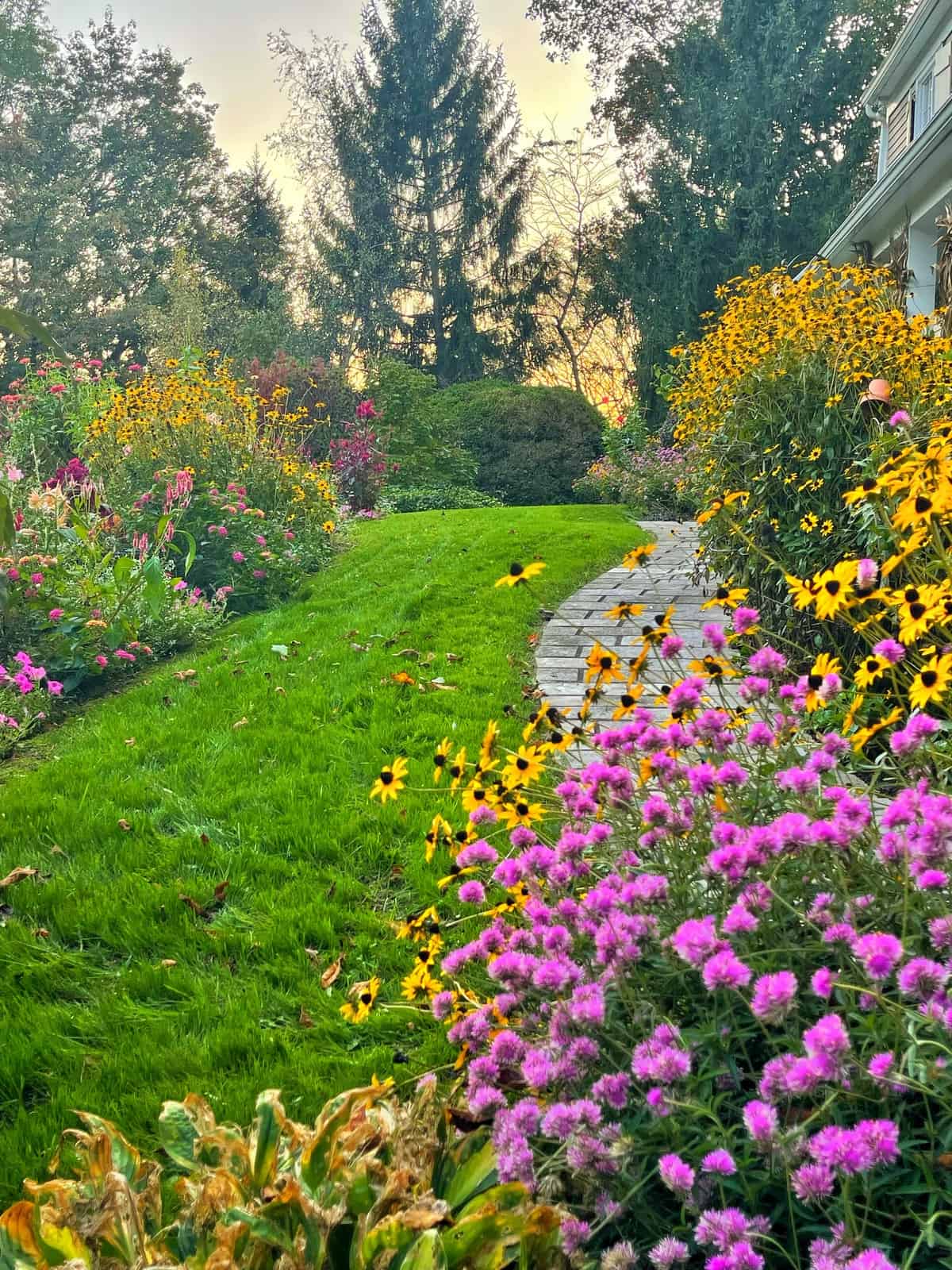
Use Natural Materials
To enhance the rustic charm of your cottage garden, incorporate natural materials like wood, stone, and clay. A classic picket fence can define your garden space and create a charming backdrop for your flowers. Stone pathways winding through the garden add a touch of whimsy and invite you to explore.
Create Pathways in Your Cottage Garden Design
Speaking of pathways, they’re a wonderful way to add structure and charm to your cottage garden. Gravel or stepping stones create a welcoming feel and make it easier to access different parts of the garden for maintenance.
Cottage Garden Ideas: Create a Seating Area
What’s the point of having a beautiful garden if you can’t sit back and enjoy it? Create a cozy seating area within or near your garden where you can relax and soak in the beauty you’ve created. A simple bench nestled among the flowers or a patio table with a view can become your favorite spot to unwind.

Plan Around Bloom Times
To ensure your garden is a symphony of color throughout the growing season, choose plants with different bloom times. Start with early-blooming spring bulbs, then add annuals and perennials that will flower in succession throughout the summer and fall. I like to plant summer-blooming flowers alongside my spring bulbs, so that as one fades, the other is ready to take the stage.
Cottage Garden Ideas That Personalize Your Design
While it’s fun to draw inspiration from other gardens, remember to infuse your own personality into your design. Choose flowers that resonate with you, have special meaning, or simply bring you joy. Add decorative elements that reflect your interests and passions. After all, the most important thing is to have fun and create a space that feels uniquely yours.
Cottage gardens are known for their vibrant and diverse color palettes. While you can certainly choose a color theme if you want one, a great thing about cottage gardens is they can be informal, natural, and even a little wild.
Some of my favorite colors to include in blooms for a cottage garden include:
- Soft pastels like lavender, pink, and baby blue
- Bright, cheerful hues such as yellow, orange, and red
- Plenty of fresh green in varying shades
- White flowers to create contrast against colorful blooms.
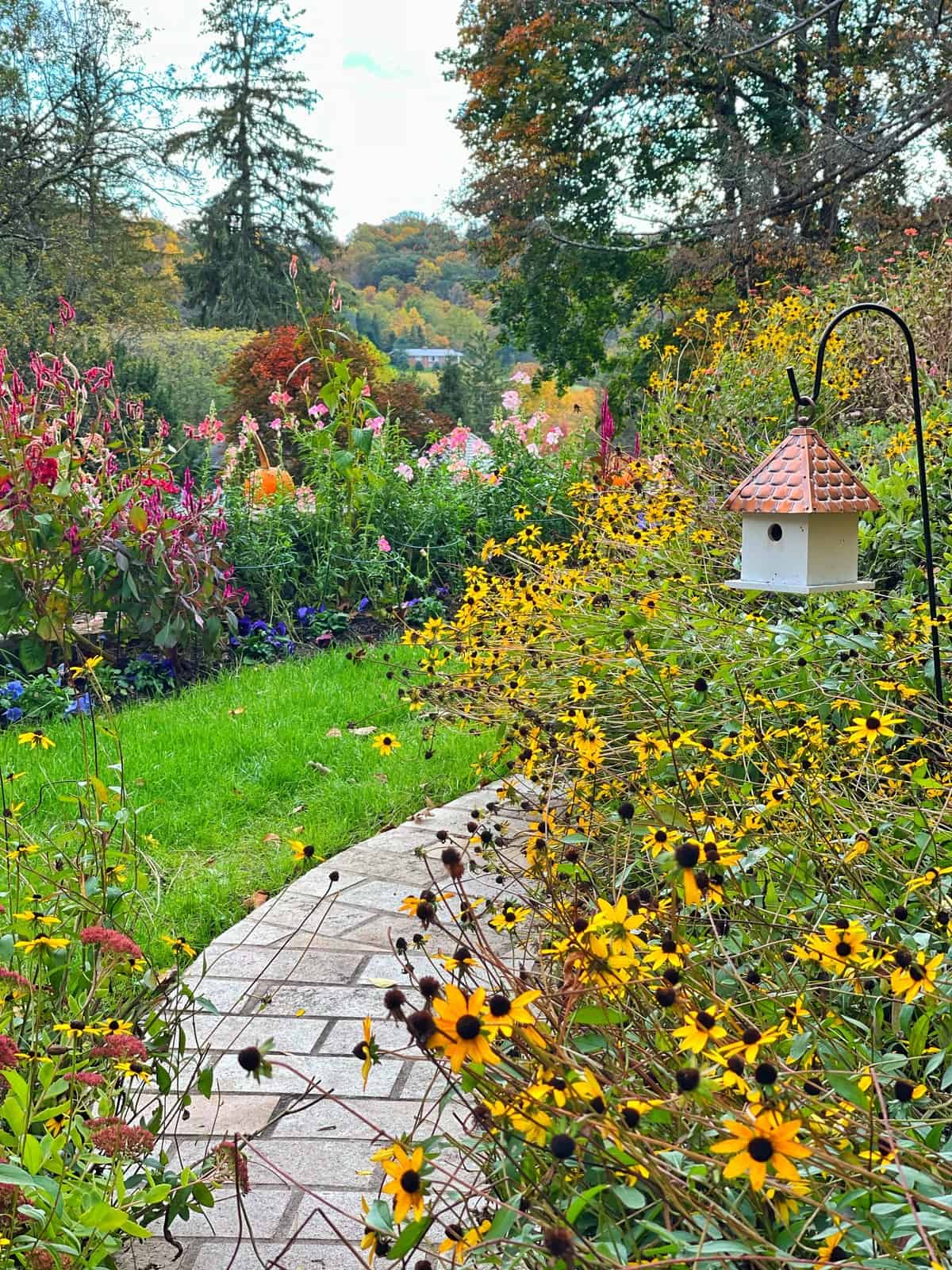

How to Grow a Low-Maintenance Cottage Garden
Creating a thriving cottage garden doesn’t have to be a time-consuming endeavor. By understanding the key elements of a low-maintenance approach, you can achieve that beautiful, abundant look without sacrificing your free time. Here’s how:
Choose the Right Location
Before you start planting, take a moment to consider the location of your future cottage garden paradise. Most cottage garden flowers crave sunshine, so aim for an area with full sun or partial shade. Good drainage is also essential, as soggy roots can spell trouble for many plants. Ideally, choose a spot that’s easily accessible and close to a water source, making watering a breeze.
Remember, not all plants are created equal when it comes to soil preferences. If your soil is heavy and tends to retain moisture, lavender might not be the best choice. To ensure you’re setting your plants up for success, I recommend getting a soil test. This will reveal your soil’s composition, nutrient levels, and any adjustments needed for optimal plant growth.

Start with Good Soil
The foundation of any thriving garden is healthy soil. Sadly, soil preparation is often overlooked, but trust me, it makes all the difference! Before you start planting, take some soil samples and send them off for testing. This will give you a clear picture of your soil’s needs and guide you in making the necessary amendments.
Adding compost and other organic matter, like leaf mold, is like giving your soil a vitamin boost. You can find bags of compost at your local nursery, but making your own is incredibly easy and rewarding. Plus, it’s a great way to recycle kitchen scraps and yard waste!
Cottage Garden Ideas: Plant a Mix of Annuals, Perennials, Bulbs, and Flowering Shrubs
To create a cottage garden that’s bursting with color and interest throughout the growing season, embrace the power of diversity! Plant a mix of annuals, perennials, spring-flowering bulbs, and shrubs.
- Annuals provide instant gratification with their vibrant blooms in the first year.
- Perennials are the gift that keeps on giving, returning year after year with their beautiful flowers.
- Spring-flowering bulbs, like daffodils and tulips, add a touch of magic to the early spring garden with minimal effort.
- Flowering shrubs provide structure, seasonal interest, and sometimes even delightful fragrance.
- And don’t forget about small evergreen trees and shrubs for year-round color and structure.
Just remember to consider the mature size of each plant before you pop it in the ground. That cute little shrub at the nursery can turn into a giant in a few years!
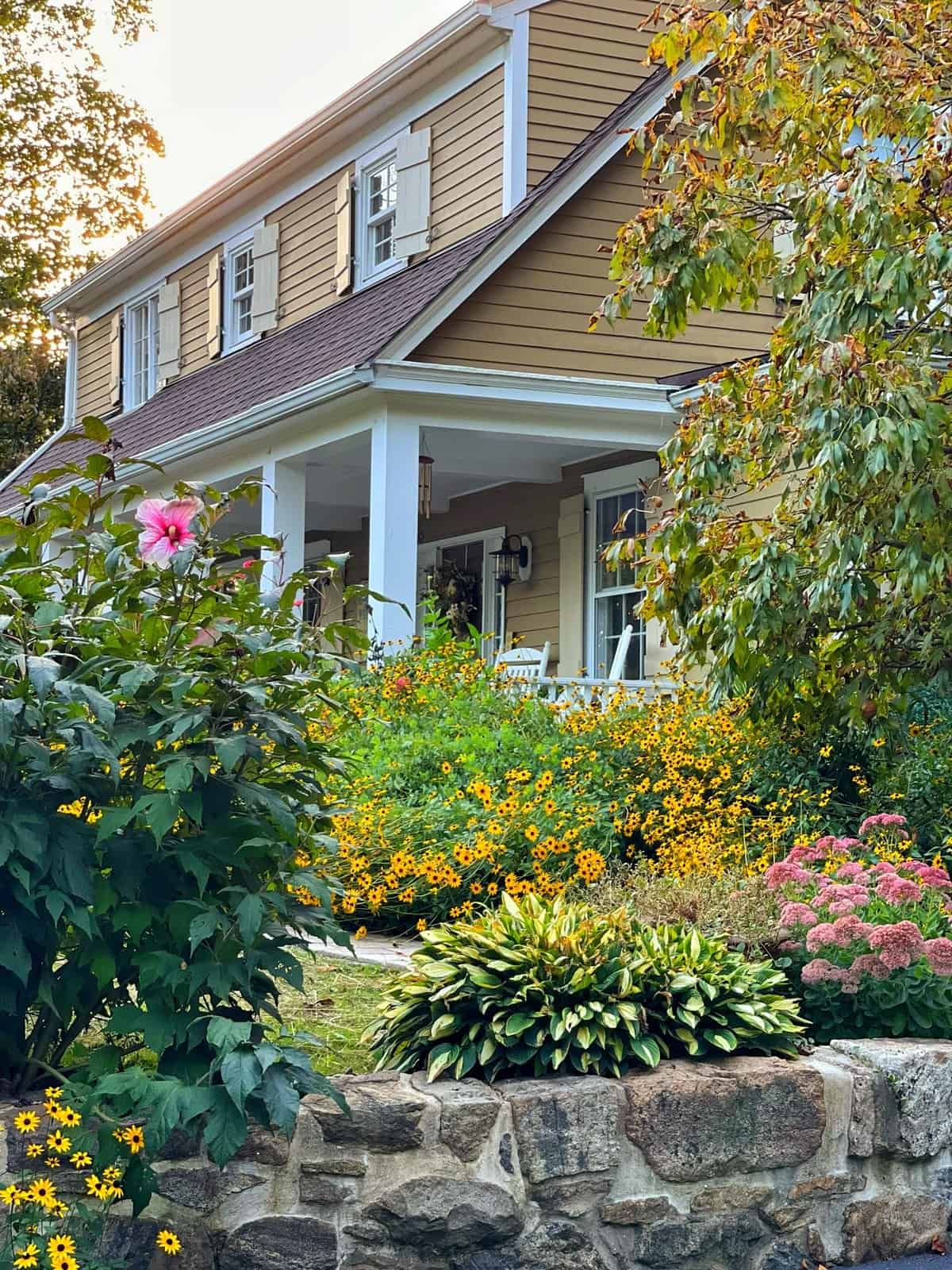
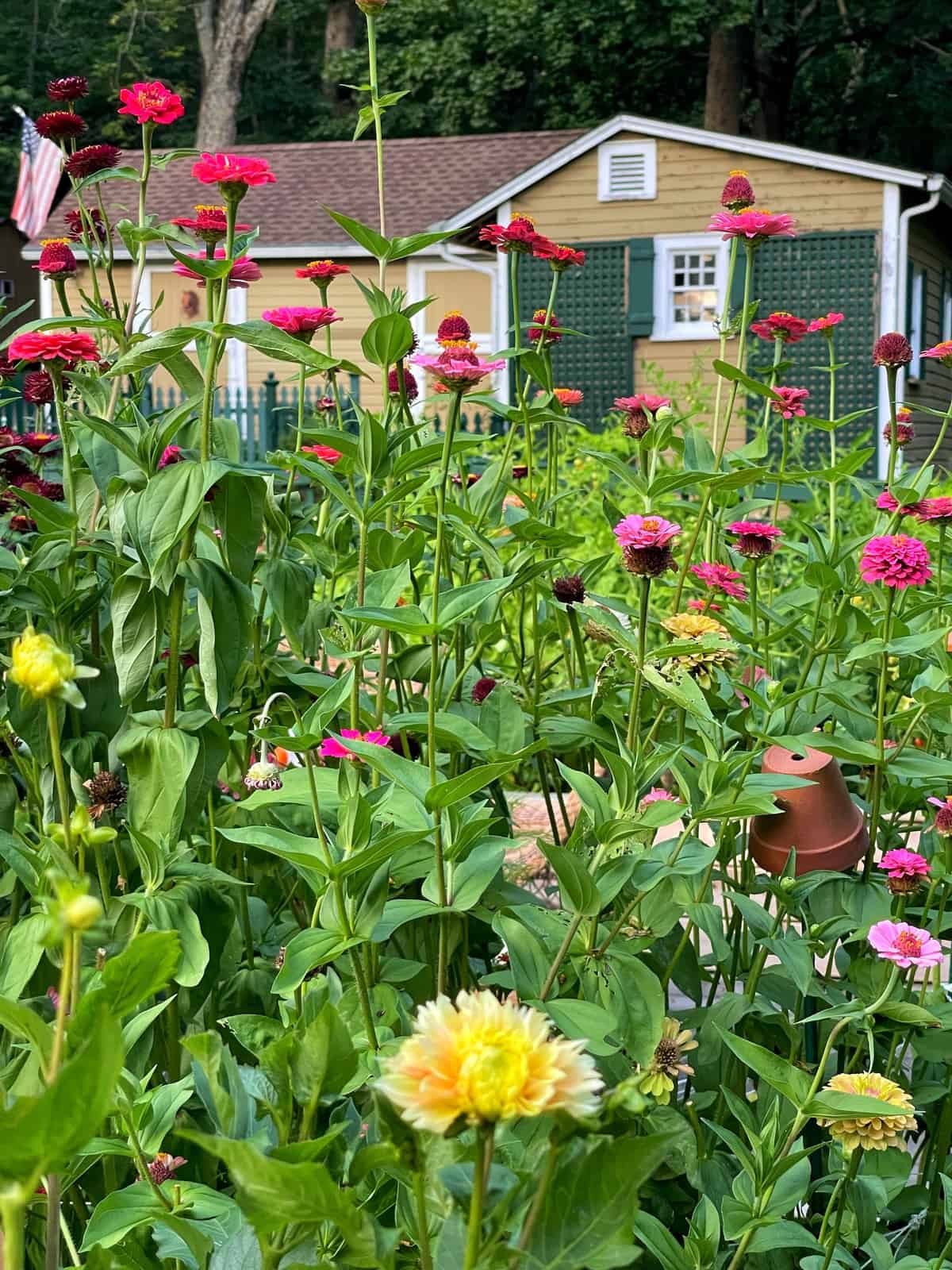
Consider Your Climate
Plants, like people, have their preferences when it comes to climate. When choosing plants for your cottage garden, be sure to consider your local conditions. Know your hardiness zone and look for plants that are native to your area or thrive in similar climates.
Native plants are a fantastic choice for low-maintenance cottage gardens. They’ve adapted to your local conditions over time, making them naturally resilient and less prone to pests and diseases. If you’re unsure about which plants are native to your area, reach out to your local cooperative extension or check the plant tags at the nursery.
Keep Up on the Weeds
Let’s face it, weeds are a fact of life in any garden. While we can’t completely eliminate them, there are ways to keep them from taking over. Regular weeding is essential, but here are a few tips to make the task less daunting:
- Mulch your garden beds. A layer of mulch helps retain moisture, suppress weeds, and regulate soil temperature.
- Plant flowers a little closer together. This creates a natural barrier that makes it harder for weeds to take root.
- Apply corn gluten meal in the spring. This natural pre-emergent herbicide can help prevent crabgrass and other weeds from germinating.
- Use newspaper or cardboard as a weed barrier. Layering these materials beneath mulch can effectively smother weeds.
Avoid using weed fabric, as it can hinder plant growth and make it more difficult to add new plants to your garden later on.

Mulch Your Garden Beds
Mulching isn’t just about weed control; it also offers a host of other benefits. A layer of mulch helps conserve moisture, protect plant roots from temperature fluctuations, and adds a polished look to your garden beds. Plus, as it breaks down, it enriches the soil, making it even more hospitable for your plants.
Water Your Cottage Garden Regularly
Consistent watering is essential, especially during the establishment phase and hot summer days. Water at the base of plants in the early morning to minimize evaporation and reduce the risk of fungal diseases. While I generally prefer to let nature take its course, I do supplement with deep watering during prolonged dry spells. Drip irrigation systems are a fantastic option for efficient, targeted watering.
Fertilize Annuals and Container Gardens
Annuals and container gardens are heavy feeders and benefit from regular fertilization. You can use a liquid fertilizer for a quick boost or opt for a slow-release fertilizer that provides nutrients over a longer period. I’m a fan of slow-release fertilizers as they require less frequent application.
Perennials, shrubs, and trees typically don’t need regular fertilization, especially if you’ve enriched the soil with compost and organic matter.

Deadhead and Prune When Needed
Deadheading (removing spent blooms) encourages continuous flowering and keeps your garden looking tidy. Pruning helps maintain plant shape, remove dead or diseased branches, and promote healthy growth. However, not all plants require deadheading or pruning, so be sure to do your research and understand the needs of your specific plants.
If you’re looking for truly low-maintenance options, choose plants that bloom for an extended period and don’t require constant deadheading or pruning. Some great choices include catmint (nepeta), salvia, sedum ‘Autumn Joy,’ and hydrangeas.
Monitor for Pests and Diseases
One of the joys of gardening is the daily ritual of walking through your garden, observing the changes, and connecting with the plants. This also allows you to catch pest and disease problems early on before they get out of hand.
Look for signs of insect damage, nibbled leaves, or any unusual spots or discoloration on foliage. If you encounter a problem you’re unsure about, reach out to your local cooperative extension for guidance. They can help you identify the issue and recommend appropriate solutions.
Attract Beneficial Insects
While we want to keep harmful pests at bay, it’s equally important to welcome beneficial insects into our gardens. Bees, ladybugs, butterflies, and other pollinators play a crucial role in maintaining a healthy ecosystem and ensuring the success of your garden. They also help with seed dispersal, contributing to the natural spread and abundance of your cottage garden.
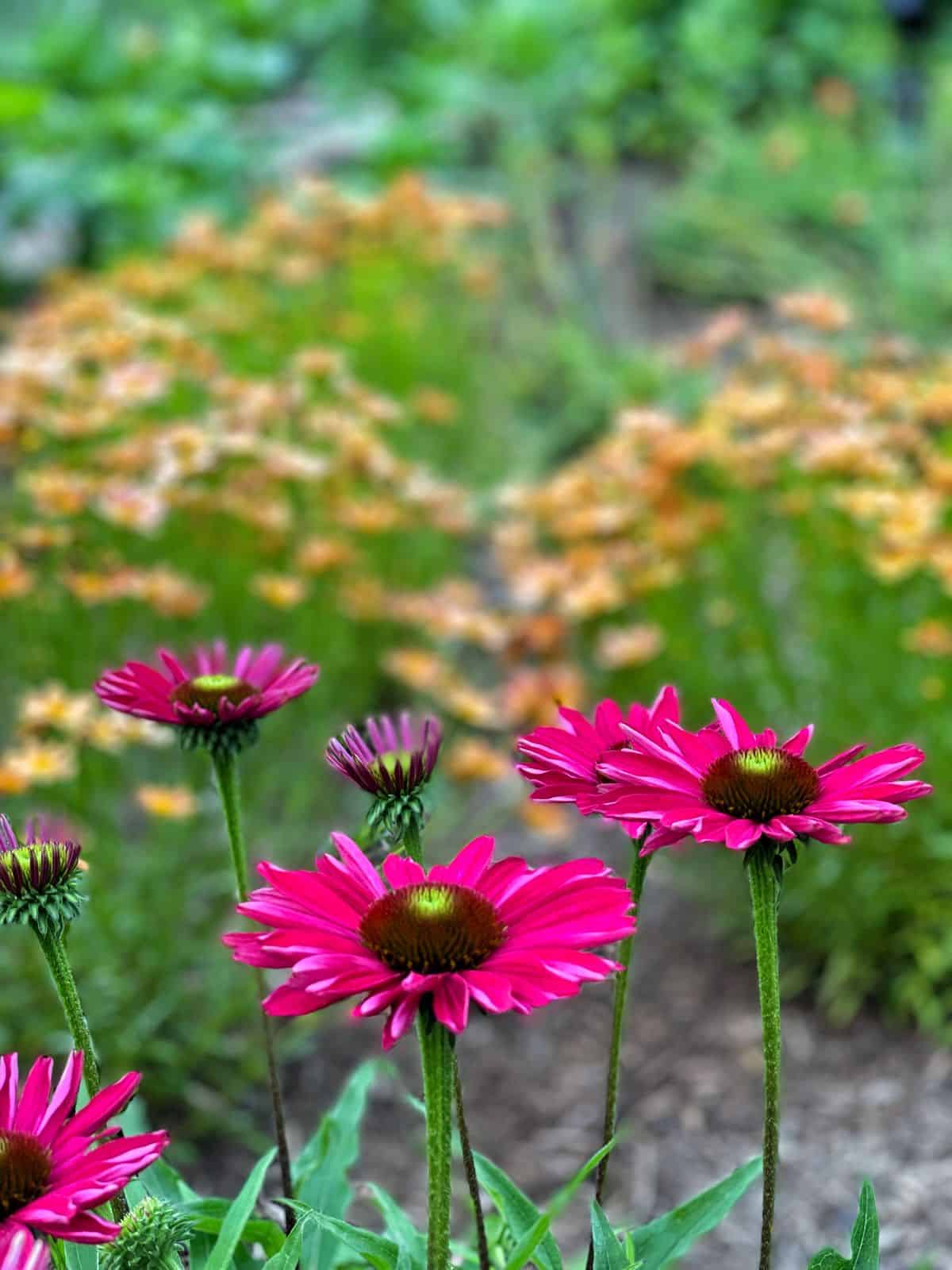
Avoiding These Cottage Garden Mistakes
While cottage gardens embrace a relaxed charm, a few missteps can hinder their potential. Here are some cottage gardening mistakes to avoid.
- Space Wisely: Resist the urge to overcrowd. Allow ample room for each plant to flourish and avoid a chaotic appearance.
- Watch the Sunlight: Match plants to their sunlight needs (full sun, part sun, or shade) for optimal growth and flowering.
- Nurture the Soil: Prepare your soil with compost or other organic matter to ensure it’s rich and well-draining.
- Water Mindfully: Avoid both overwatering and underwatering. Check soil moisture regularly and water deeply but less often.
- Choose Wisely: Research plant choices to avoid invasive species that could take over your garden.
- Deadhead Regularly: Remove spent blooms to encourage continuous flowering and maintain a tidy look.
- Vary Plant Heights: Incorporate a mix of tall, medium, and low-growing plants to create a visually appealing layered effect.
If you avoid these blunders, you’ll set your cottage garden up for success and enjoy a flourishing and beautiful space with minimal effort.

Cottage Garden Ideas: Easy Flowers to Grow
After growing flowers for more than 25 years, I’ve had the pleasure of getting to know a wide variety of plants—some that demand constant attention and others that thrive with minimal fuss. Here are a few of my favorite low-maintenance cottage garden flowers that bring beauty and joy without requiring hours of upkeep:
Cottage Garden Ideas: Spring Bloomers
- Hellebores (Lenten Rose): These charming early bloomers bring a welcome splash of color to the late winter and early spring garden. Their delicate, bell-shaped flowers in shades of pink, purple, and white often emerge while snow is still on the ground. Hellebores are deer-resistant and thrive in partial shade.
- Creeping Phlox: This ground-hugging beauty forms a fragrant carpet of blooms in spring, perfect for edging pathways or cascading over walls. It comes in a variety of colors, including pink, purple, white, and blue. Creeping Phlox prefers full sun and well-drained soil.
- Daffodils: These cheerful yellow flowers are a quintessential symbol of spring. They naturalize easily, meaning they’ll multiply and spread year after year, creating a vibrant display with minimal effort. Daffodils prefer full sun and well-drained soil.
- Tulips: With their endless variety of colors and shapes, tulips add a touch of elegance to the spring garden. They’re relatively low-maintenance, but you may need to protect them from hungry squirrels and deer. Tulips prefer full sun and well-drained soil.
- Baptisia (False Indigo): This native perennial is a showstopper with its striking blue-green foliage and spires of indigo flowers that resemble lupines. It’s also drought-tolerant and deer-resistant. Baptisia prefers full sun and well-drained soil.
- Siberian and Bearded Irises: These elegant beauties add a touch of sophistication to the cottage garden with their sword-like foliage and showy flowers in a rainbow of colors. They’re also relatively low-maintenance and drought-tolerant. Irises prefer full sun and well-drained soil.
- Peonies: These beloved perennials are known for their lush, fragrant blooms in shades of pink, white, and red. While they require some initial care to establish, they’ll reward you with decades of beauty. Peonies prefer full sun and well-drained soil.

Low-Maintenance Cottage Garden Ideas: Summer Standouts
- Salvia: There’s a salvia for every garden! These long-blooming perennials come in a wide range of colors, from vibrant reds and blues to soft pinks and purples. They’re also drought-tolerant and attract pollinators. Salvias prefer full sun and well-drained soil.
- Nepeta (Catmint): This is a must-have for any low-maintenance cottage garden! Nepeta is a workhorse, blooming for weeks on end with beautiful lavender-blue flowers that bees and butterflies adore. It’s also drought-tolerant, deer-resistant, and doesn’t require deadheading. I have a large patch of nepeta in my garden, and it’s always buzzing with activity!
- Coreopsis: These cheerful daisies bloom their hearts out from summer to fall, attracting pollinators with their bright yellow and orange flowers. They’re also drought-tolerant and deer-resistant. Coreopsis prefers full sun and well-drained soil.
- Echinacea (Coneflower): These native perennials are a pollinator paradise with their vibrant purple, pink, and white flowers. They’re also drought-tolerant and deer-resistant. Echinacea prefers full sun and well-drained soil.
- Daylilies: These tough and adaptable perennials offer a wide range of colors and bloom forms. They’re also relatively low-maintenance and drought-tolerant. Daylilies prefer full sun or partial shade and well-drained soil.
- Geraniums: These versatile annuals come in a wide variety of colors and bloom profusely throughout the summer. They’re also relatively drought-tolerant and easy to care for. Geraniums prefer full sun or partial shade and well-drained soil.
- Zinnias: These cheerful annuals are a cottage garden staple. They come in a dazzling array of colors and attract butterflies and other pollinators. Zinnias are easy to grow from seed and prefer full sun and well-drained soil.

Cottage Garden Fall Favorites
- Hydrangeas: These beloved shrubs offer long-lasting blooms in shades of pink, blue, and white. They add a touch of elegance to the late summer and fall garden. Hydrangeas prefer partial shade and moist, well-drained soil.
- Rudbeckia (Black-eyed Susan): These cheerful yellow daisies are a cottage garden classic. They’re easy to grow, attract pollinators, and bloom for a long period. Rudbeckia prefers full sun and well-drained soil.
- Alliums: These ornamental onions add a dramatic vertical element to the cottage garden with their tall, globe-shaped flower heads. They’re also deer-resistant and attract pollinators. Alliums prefer full sun and well-drained soil.
- Sedum ‘Autumn Joy’: This reliable perennial is a star of the fall garden with its rosy pink flower heads that mature to a coppery bronze. It’s also drought-tolerant and attracts butterflies. Sedum ‘Autumn Joy’ prefers full sun and well-drained soil.
This is just a small sampling of the many easy-care flowers that can thrive in a cottage garden. With a little planning and research, you can create a beautiful and abundant garden that brings you joy without demanding hours of your time.


Final Thoughts About Low-Maintenance Cottage Garden Ideas
In conclusion, a low-maintenance cottage garden is a great option for busy gardeners who want to enjoy the beauty of flowers without having to spend a lot of time on care. By using perennial flowers, annuals, herbs, and even vegetables, you can create a colorful and vibrant garden that will require less maintenance than a traditional garden.
Some easy-care perennial flowers that are perfect for cottage gardens include black-eyed susans, sedum autumn joy, and coneflowers. Other tips for creating a low-maintenance cottage garden include using a mix of plants, planting in odd numbers, and incorporating evergreens.
With a little planning and effort, you can create a beautiful and low-maintenance cottage garden that will bring you joy for years to come.

For mor information about cottage gardening, please read this article from North Carolina State University Cooperative Extension.
Are you growing a cottage garden too? What are your favorite plants to include? Do you have any cottage garden ideas you’d like to share? Let’s chat about it more in the comments below.
I also shared some cottage gardening mistakes to avoid when planning and planting your garden in this article to help you dive a bit deeper into creating one with success. And if you want to drill down on the best cottage garden plants to grow, check out my curated list in this post.
To drill down on more beginner gardening techniques and tips, please read these posts:
- Flower Gardening 101
- Growing a Cut Flower Garden for Beginners
- Container Garden Ideas for Beginners
- How to Start a Vegetable Garden
- Herb Gardening for Beginners
Thanks so much for dropping by the blog today.
I hope you are inspired to grow your own cottage garden! Happy Gardening! xo





